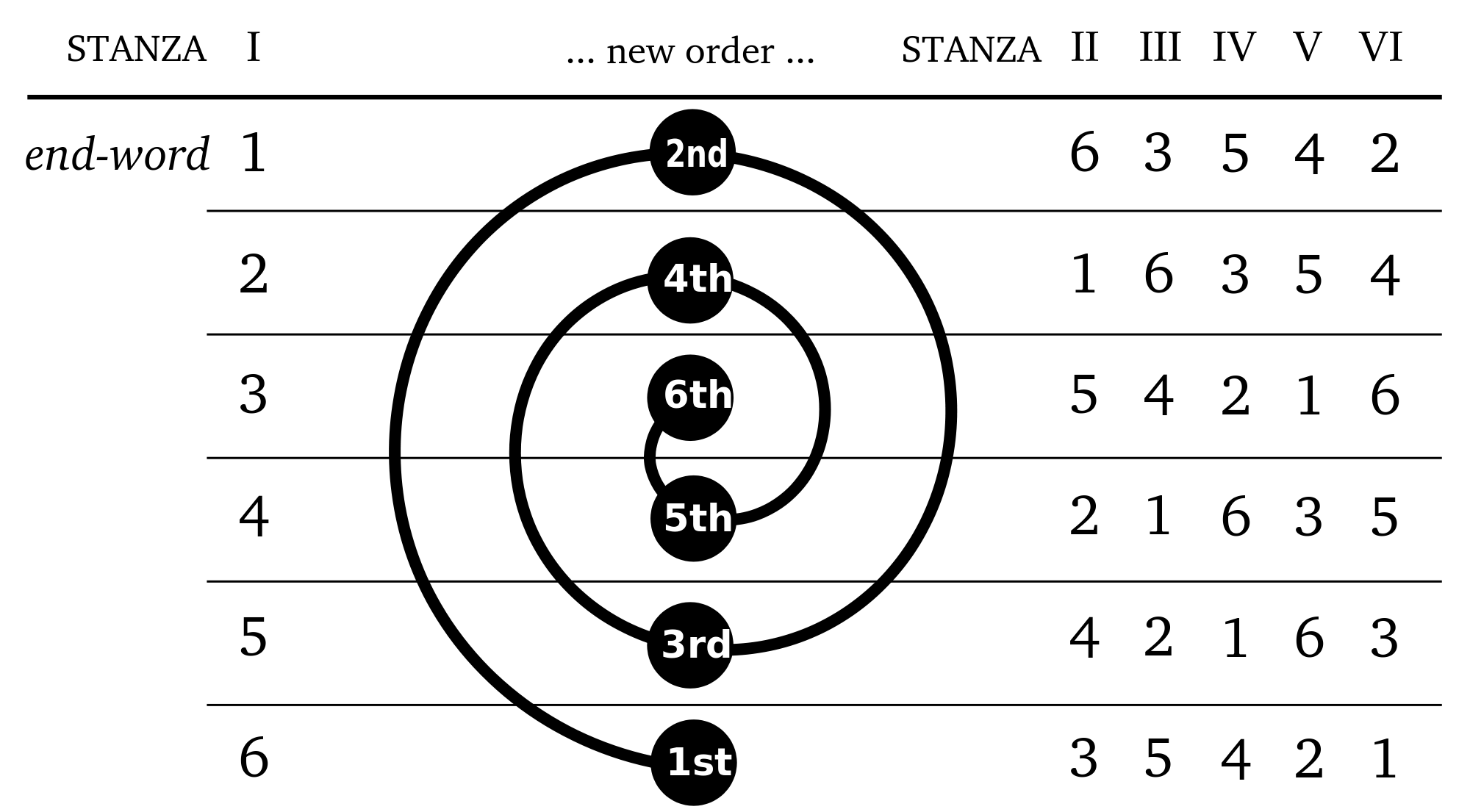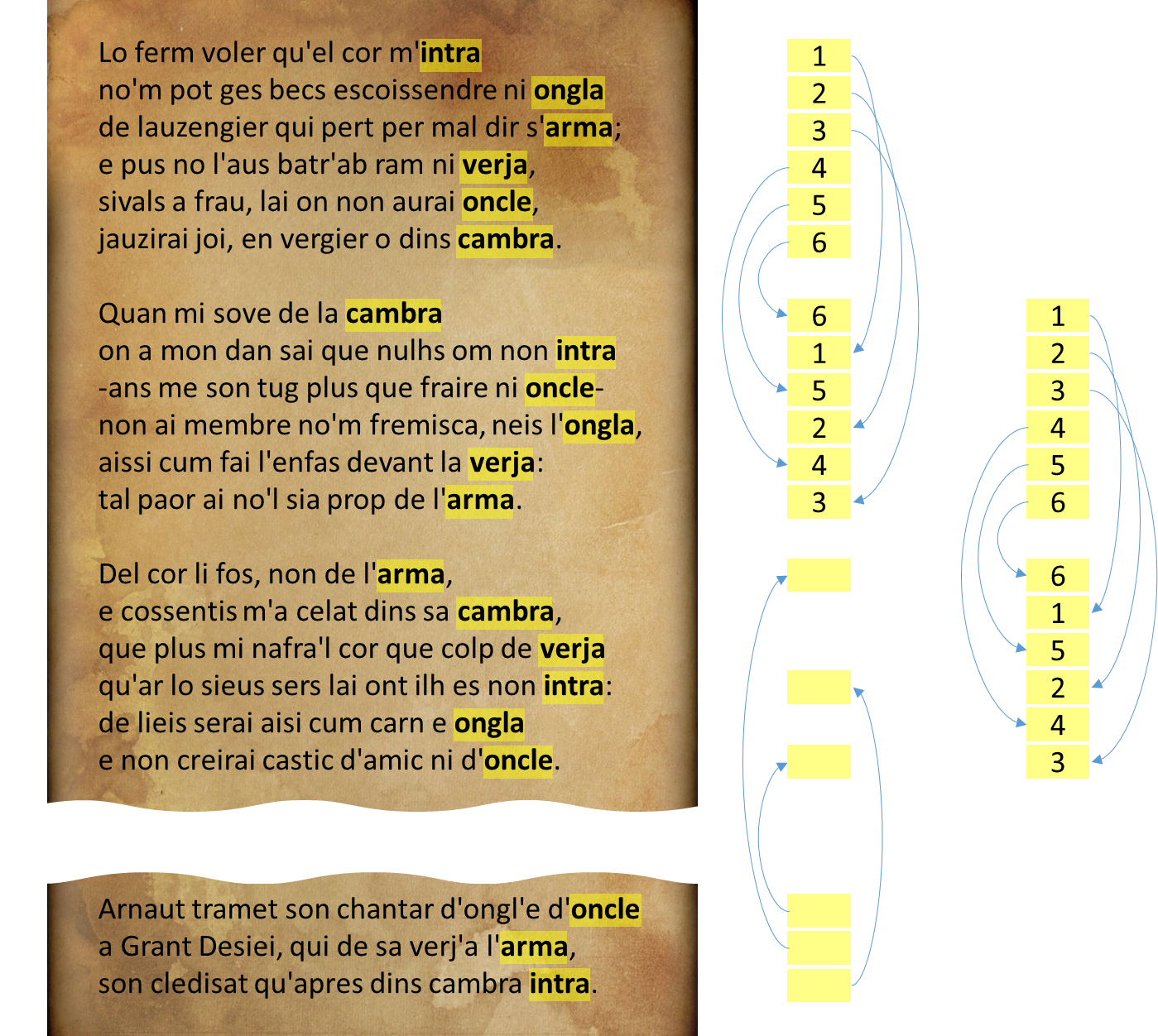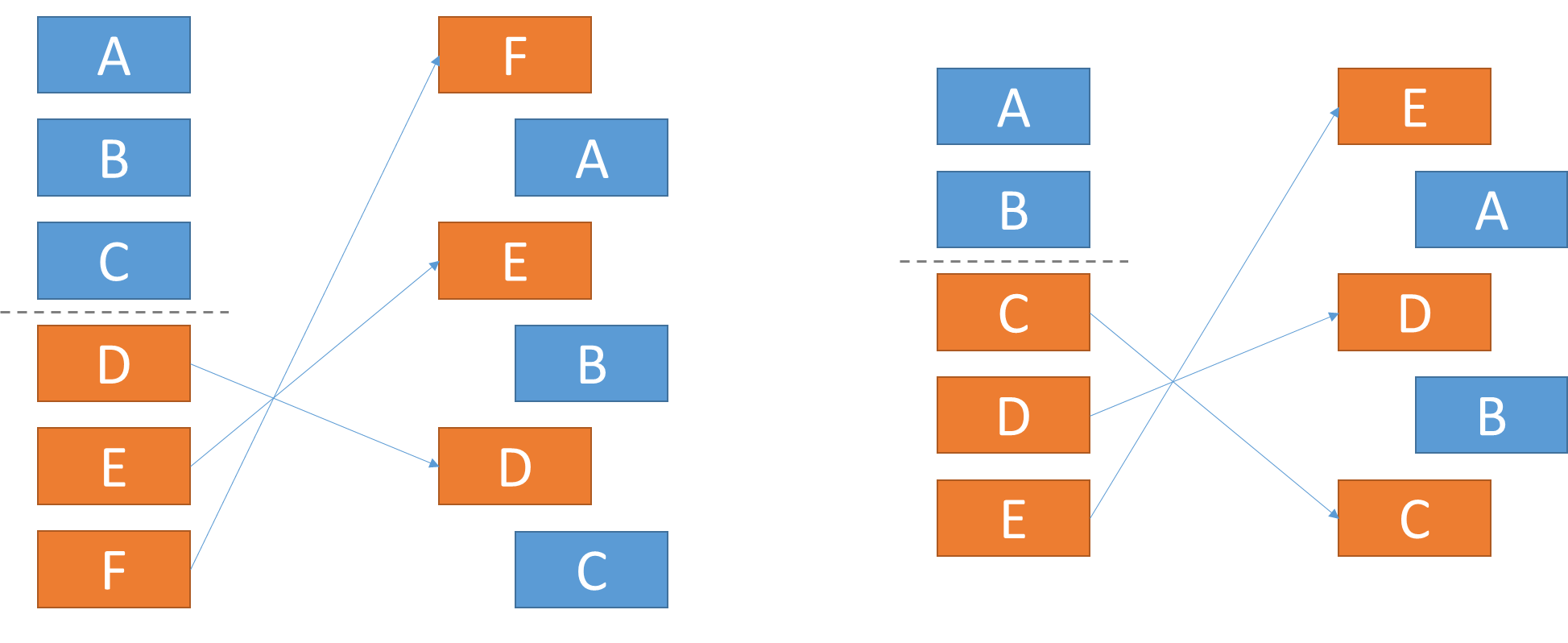PROG0042 - Sestina
The sestina is an unusual form of poetry that must comply to very stringent rules. Each sestina has six stanzas that use the same six line-ending words, rotated according to a set pattern:
A sestina may end in an envoi: a seventh three-line stanza. This intriguingly insistent form has appealed to verse writers since the 12th century. John Frederick Nims describes it in the following way:
In a good sestina the poet has six words, six images, six ideas so urgently in his mind that he cannot get away from them. He wants to test them in all possible combinations and come to a conclusion about their relationship.
The oldest-known sestina is Lo ferm voler qu'el cor m'intra written around 1200 by Arnaut Daniel, a troubadour of Aquitanian origin. He refers to it using the Occitan term cledisat, meaning, more or less, interlock. Hence, Daniel is generally considered the form's inventor, though it has been suggested that he may only have innovated an already existing form.
Assignment
The number six plays a key role in the rules defining a sestina. In this assignment you are asked to check whether or not a given poem — whose lines are stored in a text file — complies to a set of very stringent rules that resemble those of the sestina. However, we will not fixes the rules to the number six, but formulate them more generally in terms of the integer $n \in \mathbb{N}_0$. Before we come to a listing of the rules, we must first be clear about some basic concepts.
A poem consists of a sequence of stanzas that each consist of a sequence of lines, with stanzas separated from each other by at least one empty line. An empty line is a line that only contains whitespace characters (spaces, tabs and/or newlines). Empty lines may also occur before the first stanza and after the last stanza of the poem. The words of a poem are defined as the longest possible sequence of letters. Each line in a stanza contains at least one word, and the last word of the line is called its endword.
A permutation of a sequence of $n$ elements is a sequence of $n$ elements that results from rearranging the elements of the original sequence. A permutation is represented by a list containing the integers 1 up to $n$, in a random order. For example, the list [6, 1, 5, 2, 4, 3] represents the permutation that has the sixth element in the original sequence as its first element, followed by the first, fifth, second, forth and third elements of the original sequence.
The canonical permutation of a sequence of $n$ elements is determined using the following procedure. Split the $n$ elements into two halves. In case $n$ is odd, the second half has one additional element compared to the first half. Reverse the order of the elements in the second half, and have each of those elements followed by the next element in the first half. The scheme below illustrates this procedure for an even (left) and odd (right) number of elements. This canonical permutation is the default permutation used to determine the order of the endwords in a sestina (for $n = 6$) and a pentina (for $n = 5$).
For a given poem we determine $n \in \mathbb{N}_0$ as the number of lines in its first stanza. The rules to which a sestina-like poem has to comply are:
- the poem has $n$ stanzas that each have $n$ lines, possibly followed by an additional stanza (the envoi) that has $\lfloor \frac{n}{2} \rfloor$ lines; the notation $\left \lfloor{x}\right \rfloor \in \mathbb{N}$ denotes the integer part of $x \in \mathbb{R}^{+}$
- applying a given permutation on the sequence of endwords of the first $n - 1$ stanzas each time results in the sequence of endwords of the next stanza; comparison between endwords must be case insensitive
- the endwords of the envoi (if present) are also used as endwords in the other stanzas; comparison between endwords must be case insensitive; we want to stress that in contrast to the first $n$ stanzas, there are no restrictions on the order of the endwords of the envoi
You must proceed as follows to check whether or not a given poem complies to the above rules:
- Write a function endword that takes a string as its argument. The function may assume that the given string has at least one word and must return its endword.
- Write a function stanzas that takes the location of a text file containing the lines of a poem. The function must return a list containing the sequence of stanzas in the poem. Each stanza must itself be represented as a list containing the endwords of its lines. All endwords must be converted into lowercase letters.
- Write a function permutation that takes a list of $n \in \mathbb{N}_0$ elements. The function also has a second optional parameter pattern that may take a list of numbers that should represent a permutation of a sequence of $n$ elements. The function must return a new list the contains the given permutation of the elements in the given list. If the value passed to the parameter pattern does not represent a rearrangement of the integers 1 up to and including $n$, the function must raise an AssertionError with the message invalid permutation. If no value was explicitly passed to the parameter pattern, the function must return the canonical permutation of the given list of elements.
- Write a function sestina that takes the location of a text file containing the lines of a poem. The function also has a second optional parameter pattern that has the same meaning as with the function permutation. The function must return a Boolean value that indicates wheter or not the given poem complies to all rules for sestina-like poems as given above. In checking the second rule, the function must of course make use of the permutation that is described by the argument passed to the parameter pattern.
Example
The following interactive session assumes that the text files sestina0.txt, sestina1.txt and sestina2.txt are located in the current directory.
>>> endword("Lo ferm voler qu'el cor m'intra") 'intra' >>> endword("no'm pot ges becs escoissendre ni ongla") 'ongla' >>> endword("de lauzengier qui pert per mal dir s'arma;") 'arma' >>> stanzas('sestina0.txt') [['intra', 'ongla', 'arma', 'verja', 'oncle', 'cambra'], ['cambra', 'intra', 'oncle', 'ongla', 'verja', 'arma'], ['arma', 'cambra', 'verja', 'intra', 'ongla', 'oncle'], ['oncle', 'arma', 'ongla', 'cambra', 'intra', 'verja'], ['verja', 'oncle', 'intra', 'arma', 'cambra', 'ongla'], ['ongla', 'verja', 'cambra', 'oncle', 'arma', 'intra'], ['oncle', 'arma', 'intra']] >>> stanzas('sestina1.txt') [['enters', 'nail', 'soul', 'rod', 'uncle', 'room'], ['room', 'enters', 'uncle', 'nail', 'rod', 'soul'], ['soul', 'room', 'rod', 'enters', 'nail', 'uncle'], ['uncle', 'soul', 'nail', 'room', 'enters', 'rod'], ['rod', 'uncle', 'enters', 'soul', 'room', 'nail'], ['nail', 'rod', 'room', 'uncle', 'soul', 'enters'], ['nail', 'soul', 'enters']] >>> stanzas('sestina2.txt') [['woe', 'sound', 'cryes', 'part', 'sleepe', 'augment'], ['augment', 'woe', 'sound', 'cryes', 'part', 'sleepe'], ['sleepe', 'augment', 'woe', 'sound', 'cryes', 'part'], ['part', 'sleepe', 'augment', 'woe', 'sound', 'cryes'], ['cryes', 'part', 'sleepe', 'augment', 'woe', 'sound'], ['sound', 'cryes', 'part', 'sleepe', 'augment', 'woe'], ['sound', 'part', 'augment']] >>> permutation(['rose', 'love', 'heart', 'sang', 'rhyme', 'woe']) ['woe', 'rose', 'rhyme', 'love', 'sang', 'heart'] >>> permutation(['woe', 'rose', 'rhyme', 'love', 'sang', 'heart']) ['heart', 'woe', 'sang', 'rose', 'love', 'rhyme'] >>> permutation(['rose', 'love', 'heart', 'sang', 'rhyme']) ['rhyme', 'rose', 'sang', 'love', 'heart'] >>> permutation(['rose', 'love', 'heart', 'sang', 'rhyme', 'woe'], [6, 1, 5, 2, 4, 3]) ['woe', 'rose', 'rhyme', 'love', 'sang', 'heart'] >>> permutation(['rose', 'love', 'heart', 'sang', 'rhyme', 'woe'], [6, 5, 4, 3, 2, 1]) ['woe', 'rhyme', 'sang', 'heart', 'love', 'rose'] >>> permutation(['rose', 'love', 'heart', 'sang', 'rhyme', 'woe'], [6, 1, 5, 3, 4, 3]) Traceback (most recent call last): AssertionError: invalid permutation >>> sestina('sestina0.txt') True >>> sestina('sestina0.txt', [6, 1, 5, 2, 4, 3]) True >>> sestina('sestina1.txt') True >>> sestina('sestina2.txt') False >>> sestina('sestina2.txt', [6, 1, 2, 3, 4, 5]) True
De sestina is een dichtvorm waarbij aan zeer strikte voorwaarden moet voldaan worden. Een sestina bestaat immers uit zes stanza's (verzen) van zes regels, waarbij elk stanza eindigt op dezelfde zes woorden die volgens een vast patroon gepermuteerd worden.
Een sestina kan eventueel nog afgesloten worden door een envoi: een zevende stanza van drie regels. Sinds de twaalfde eeuw heeft dit intrigerende strakke keurslijf menig dichter geïnspireerd. John Frederick Nims omschreef de dichtvorm op de volgende manier:
In een goede sestina spoken zes woorden, zes beelden, zes ideeën zo hard door het hoofd van de dichter dat hij er moeilijk aan kan ontsnappen. Hij wil ze in alle mogelijke combinaties wringen om te achterhalen hoe ze met elkaar verbonden zijn.
De oudste bekende sestina is Lo ferm voler qu'el cor m'intra die rond 1200 werd geschreven door Arnaut Daniel, een troubadour uit de streek van Aquitanië (Frankrijk). Hij wordt dan ook aanzien als de uitvinder van de dichtvorm die hij zelf benoemde met de Occitaanse term cledisat, wat min of meer dezelfde betekenis heeft als "verweven".
Opgave
In een sestina speelt het getal zes een voorname rol. Voor deze opgave vragen we je om te controleren of een gegeven gedicht — waarvan de tekst is opgeslagen in een tekstbestand — voldoet aan een reeks zeer strikte voorwaarden die sterk lijken op de voorwaarden van een sestina. We zullen ons echter niet vastpinnen op het getal zes, maar de voorwaarden algemener formuleren in functie van een getal $n \in \mathbb{N}_0$. Voor we komen tot een oplijsting van de voorwaarden, moeten we eerst nog een aantal andere dingen vastleggen.
Een gedicht bestaat uit een aantal stanza's die elk bestaan uit een aantal opeenvolgende regels tekst en van elkaar worden gescheiden door minstens één lege regel. Een lege regel is een regel die enkel witruimtekarakters bevat (spaties, tabs en/of newlines). Ook vóór het eerste stanza en na het laatste stanza kunnen lege regels voorkomen. De woorden van het gedicht worden gevormd door de langst mogelijke opeenvolging van letters. Elke regel van een stanza bevat minstens één woord, en het laatste woord van een regel wordt het eindwoord genoemd.
Een permutatie van een reeks van $n$ elementen is een reeks van $n$ elementen die volgt na herschikking van de elementen in de originele reeks. Een permutatie wordt voorgesteld door een lijst die de getallen 1 tot en met $n$ bevat, in een willekeurige volgorde. Zo stelt de lijst [6, 1, 5, 2, 4, 3] bijvoorbeeld de permutatie voor die eerst het zesde element bevat uit de originele reeks elementen, gevolgd door het eerste, het vijfde, het tweede, het vierde en het derde element van de originele reeks.
De canonieke permutatie van een reeks van $n$ elementen wordt bepaald aan de hand van de volgende procedure. Splits de $n$ elementen op in twee helften. Indien $n$ oneven is, dan bevat de tweede helft één element meer dan de eerste helft. Keer de volgorde van de elementen uit de tweede helft om, en plaats na elk van die elementen telkens het volgende element uit de eerste helft. Dit wordt hieronder geïllustreerd voor een even (links) en een oneven (rechts) aantal elementen. Deze canonieke permutatie is de standaard permutatie die gebruikt wordt voor het bepalen van de volgorde van de eindwoorden in een sestina (voor $n = 6$) en een pentina (voor $n = 5$).
Voor een gegeven gedicht bepalen we $n \in \mathbb{N}_0$ als het aantal regels in het eerste stanza. De voorwaarden waaraan een sestina-achtig gedicht dan moet voldoen zijn:
- het gedicht bestaat uit $n$ stanza's van elk $n$ regels, eventueel gevolgd door een extra stanza (het envoi) van $\lfloor \frac{n}{2} \rfloor$ regels; hierbij staat $\lfloor x \rfloor \in \mathbb{N}$ voor het geheel deel van $x \in \mathbb{R}^{+}$
- toepassen van een gegeven permutatie op de eindwoorden van de eerste $n - 1$ stanza's levert telkens de volgorde op van de eindwoorden van het volgende stanza; bij het vergelijken van de eindwoorden mag geen onderscheid gemaakt worden tussen hoofdletters en kleine letters
- de eindwoorden van het envoi (indien aanwezig) zijn ook eindwoorden van de andere stanza's; bij het vergelijken van de eindwoorden mag geen onderscheid gemaakt worden tussen hoofdletters en kleine letters; merk dus op dat er in tegenstelling tot de eerste $n$ stanza's geen voorwaarden opgelegd worden aan de volgorde waarin de eindwoorden voorkomen in het envoi
Om te controleren of een gegeven gedicht aan deze voorwaarden voldoet, gaan we als volgt te werk:
- Schrijf een functie eindwoord waaraan een string moet doorgegeven worden. De functie moet het eindwoord van deze string teruggeven, en mag er daarbij van uitgaan dat de string minstens één woord bevat.
- Schrijf een functie stanzas waaraan de locatie van een tekstbestand moet doorgegeven worden waarin de tekst van een gedicht zit opgeslagen. De functie moet een lijst teruggeven met de opeenvolgende stanza's van het gedicht. Hierbij wordt elk stanza voorgesteld door een lijst van eindwoorden van de opeenvolgende regels van het stanza. Alle eindwoorden moeten omgezet worden naar kleine letters.
- Schrijf een functie permutatie waaraan een lijst van $n \in \mathbb{N}_0$ elementen moet doorgegeven worden. De functie heeft ook nog een tweede optionele parameter patroon waaraan een lijst van getallen kan doorgegeven worden, die een permutatie van een reeks van $n$ elementen moet voorstellen. De functie moet een nieuwe lijst teruggeven die de gegeven permutatie van de elementen in de gegeven lijst bevat. Indien de waarde die aan de parameter patroon wordt doorgegeven geen herschikking voorstelt van de getallen 1 tot en met $n$, dan moet de functie een AssertionError opwerpen met de boodschap ongeldige permutatie. Indien niet expliciet een waarde wordt doorgegeven aan de parameter patroon, dan moet de functie de canonieke permutatie van de elementen in de gegeven lijst teruggeven.
- Schrijf een functie sestina waaraan de locatie van een tekstbestand moet doorgegeven worden waarin de tekst van een gedicht zit opgeslagen. De functie heeft ook nog een tweede optionele parameter patroon die dezelfde betekenis heeft als bij de functie permutatie. De functie moet een Booleaanse waarde teruggeven die aangeeft of het gegeven gedicht voldoet aan alle voorwaarden die we hierboven hebben opgelegd aan een sestina-achtig gedicht. Bij het controleren van de tweede voorwaarde moet uiteraard gebruik gemaakt worden van de permutatie die omschreven wordt door het argument dat werd doorgegeven aan de parameter patroon.
Voorbeeld
Bij onderstaande voorbeeldsessie gaan we ervan uit dat de tekstbestanden sestina0.txt, sestina1.txt en sestina2.txt zich in de huidige directory bevinden.
>>> eindwoord("Lo ferm voler qu'el cor m'intra") 'intra' >>> eindwoord("no'm pot ges becs escoissendre ni ongla") 'ongla' >>> eindwoord("de lauzengier qui pert per mal dir s'arma;") 'arma' >>> stanzas('sestina0.txt') [['intra', 'ongla', 'arma', 'verja', 'oncle', 'cambra'], ['cambra', 'intra', 'oncle', 'ongla', 'verja', 'arma'], ['arma', 'cambra', 'verja', 'intra', 'ongla', 'oncle'], ['oncle', 'arma', 'ongla', 'cambra', 'intra', 'verja'], ['verja', 'oncle', 'intra', 'arma', 'cambra', 'ongla'], ['ongla', 'verja', 'cambra', 'oncle', 'arma', 'intra'], ['oncle', 'arma', 'intra']] >>> stanzas('sestina1.txt') [['enters', 'nail', 'soul', 'rod', 'uncle', 'room'], ['room', 'enters', 'uncle', 'nail', 'rod', 'soul'], ['soul', 'room', 'rod', 'enters', 'nail', 'uncle'], ['uncle', 'soul', 'nail', 'room', 'enters', 'rod'], ['rod', 'uncle', 'enters', 'soul', 'room', 'nail'], ['nail', 'rod', 'room', 'uncle', 'soul', 'enters'], ['nail', 'soul', 'enters']] >>> stanzas('sestina2.txt') [['woe', 'sound', 'cryes', 'part', 'sleepe', 'augment'], ['augment', 'woe', 'sound', 'cryes', 'part', 'sleepe'], ['sleepe', 'augment', 'woe', 'sound', 'cryes', 'part'], ['part', 'sleepe', 'augment', 'woe', 'sound', 'cryes'], ['cryes', 'part', 'sleepe', 'augment', 'woe', 'sound'], ['sound', 'cryes', 'part', 'sleepe', 'augment', 'woe'], ['sound', 'part', 'augment']] >>> permutatie(['rose', 'love', 'heart', 'sang', 'rhyme', 'woe']) ['woe', 'rose', 'rhyme', 'love', 'sang', 'heart'] >>> permutatie(['woe', 'rose', 'rhyme', 'love', 'sang', 'heart']) ['heart', 'woe', 'sang', 'rose', 'love', 'rhyme'] >>> permutatie(['rose', 'love', 'heart', 'sang', 'rhyme']) ['rhyme', 'rose', 'sang', 'love', 'heart'] >>> permutatie(['rose', 'love', 'heart', 'sang', 'rhyme', 'woe'], [6, 1, 5, 2, 4, 3]) ['woe', 'rose', 'rhyme', 'love', 'sang', 'heart'] >>> permutatie(['rose', 'love', 'heart', 'sang', 'rhyme', 'woe'], [6, 5, 4, 3, 2, 1]) ['woe', 'rhyme', 'sang', 'heart', 'love', 'rose'] >>> permutatie(['rose', 'love', 'heart', 'sang', 'rhyme', 'woe'], [6, 1, 5, 3, 4, 3]) Traceback (most recent call last): AssertionError: ongeldige permutatie >>> sestina('sestina0.txt') True >>> sestina('sestina0.txt', [6, 1, 5, 2, 4, 3]) True >>> sestina('sestina1.txt') True >>> sestina('sestina2.txt') False >>> sestina('sestina2.txt', [6, 1, 2, 3, 4, 5]) True
| Added by: | Peter Dawyndt |
| Date: | 2011-07-24 |
| Time limit: | 10s |
| Source limit: | 50000B |
| Memory limit: | 1536MB |
| Cluster: | Cube (Intel G860) |
| Languages: | PY_NBC |
| Resource: | None |




 RSS
RSS